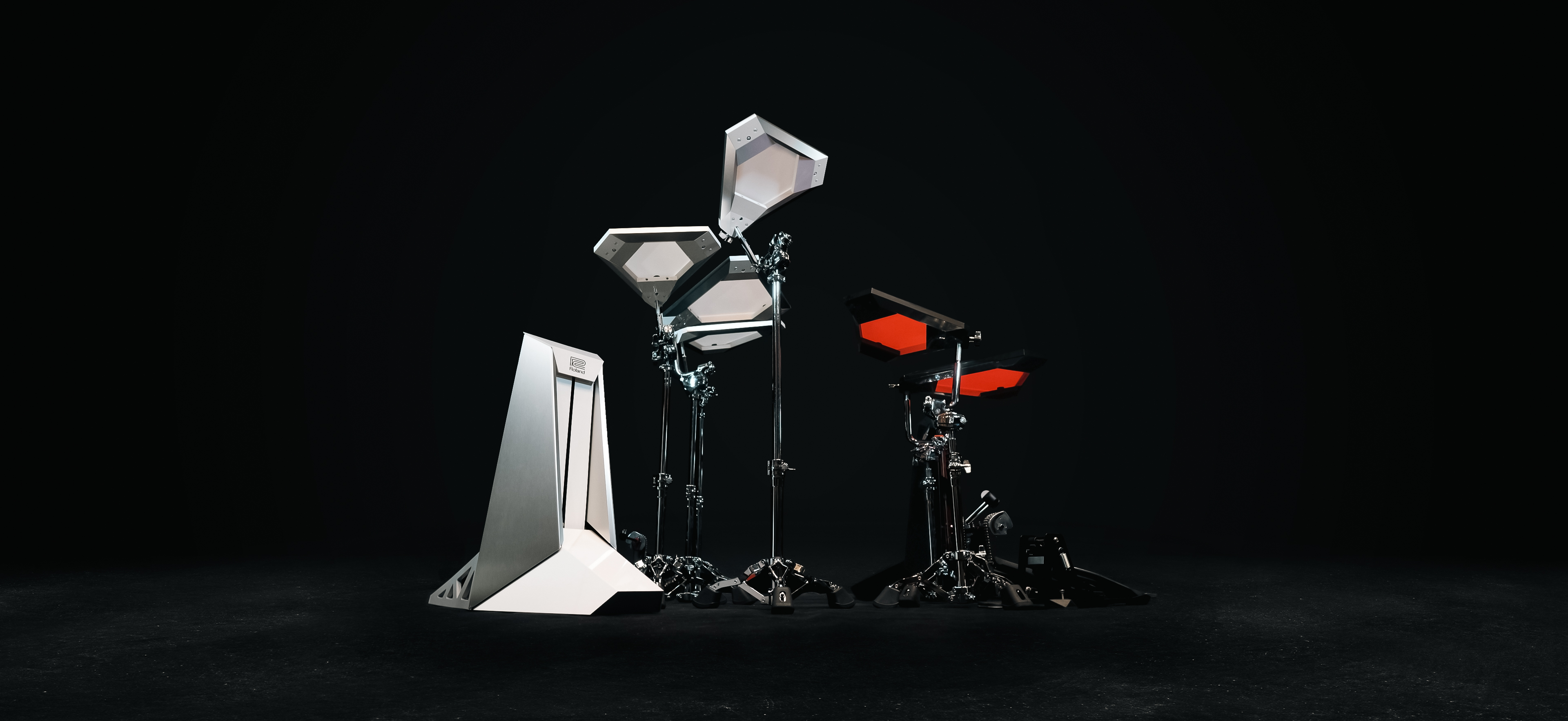Picture electronic drums and one likely imagines Roland’s game-changing V-Drums. Beloved by drummers worldwide, V-Drums have helped redefine the concept of drums. While influential, V-Drums are a single part of a long Roland drum history. From the innovative Alpha Drums to the game-changing SPD series, including the SPD-SX PRO, there have been many Roland electronic percussion instruments, each a step on the company’s path of rhythmic evolution. Explore the story of ground-breaking Roland drums—starting with the earliest days and looking far into the future.
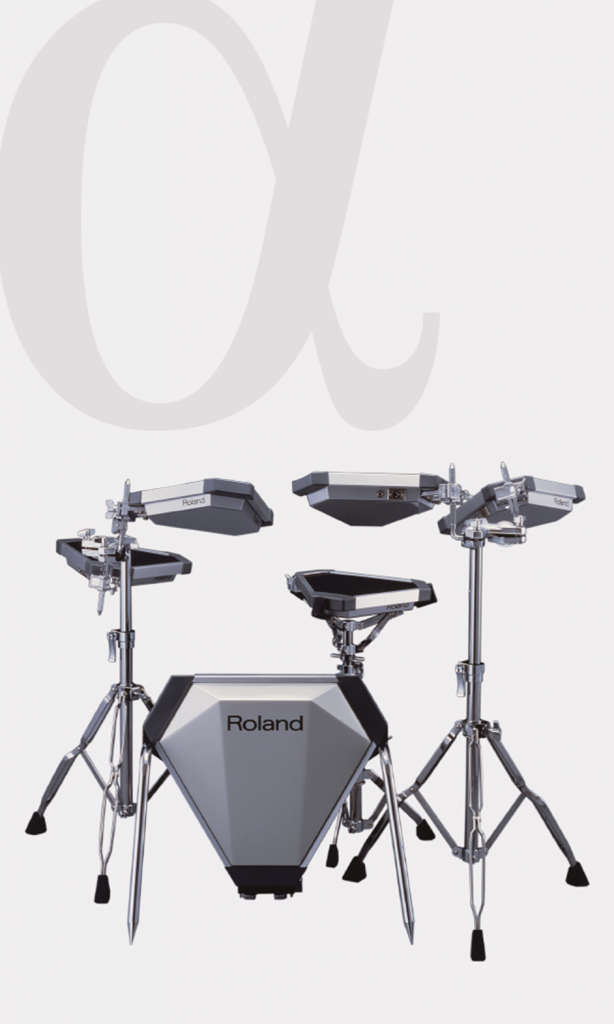
With a Bang
Thanks to the early-’80s interest in electronic drums, Roland decided to throw its hat in the ring. The result was 1985’s α Drum, the company’s first electronic drum kit. The Alpha Drum System included the DDR-30 brain and PD-10 and PD-20 pads. The DDR-30 was a 2U rackmount unit, much like the MKS lineup of synths.
The DDR-30 used PCM sample synthesis—the equivalent of 12-bit sonic fragments—for kick, snare, and tom sounds. Players could adjust the expression of the sounds via 16 parameters. These included attack and decay, gate length, EQ, and trigger sensitivity. Drummers could also trigger sounds via MIDI or pads made from plywood and rubber, with a special film attached to the striking surface to provide a natural bounce.
A Striking Triangle
The large kick PD-10 pad and smaller PD-20 pads were visually striking: silver and black, with a unique shape. Many famous drummers sat behind these distinctive drums. The list includes Peter Gill of Frankie Goes To Hollywood, Michael Giles of King Crimson, and Walfredo Reys Jr.
“In terms of design, the Simmons were hexagonal, and the Pearls were pentagonal,” explains former designer Akihiko Fukuoka. “In addition to differentiating ourselves from other companies, we chose the triangle shape because it makes it easy to arrange the pads into a full kit.”
"We chose the triangle shape because it gave musicians the freedom to play around with the setup to facilitate performance."
Akihiko Fukuoka
The Alpha Drums System was Roland’s first foray into electronic drums, so naturally, there were many challenges to overcome. “The three elements of electronic drum development—drum pad development, sensing mechanism of the sensor signal on the pad, and the expression of the drum sound source—were our first efforts,” engineer Masato Katsuda says. “There were many aspects that I struggled with, but this experience led to developing other electronic drums later.”
New Brain and Pads
In 1987, Roland followed up the DDR-30 with the PM-16, a drum module with trigger-to-MIDI functionality. MIDI was invented in 1981, and Roland wanted to develop MIDI-compatible models throughout the company. According to Katsuda, it was a drum that triggered sound with a dedicated sound module for an electronic drum or with an external sound module such as a sampler or drum machine.
1987 also saw Roland release a new series of pads: the PD-11, PD-21, and PD-31. Although they retained the distinctive triangular shape, they were a vast improvement physically. “Many electronic drums at the time were structurally stiff,” says former designer Kiyoshi Yoshino. “And the drawback was if you hit it for too long, your wrist would hurt.”
To keep drummers happy and able to play for long periods, he employed a bellows structure around the striking surface. This innovation helped reproduce the sinking of the stick during play. They could also trigger four sounds, with one in the center pad and three around the rim. “This allowed for rimshots that were impossible with Simmons,” Yoshino adds.
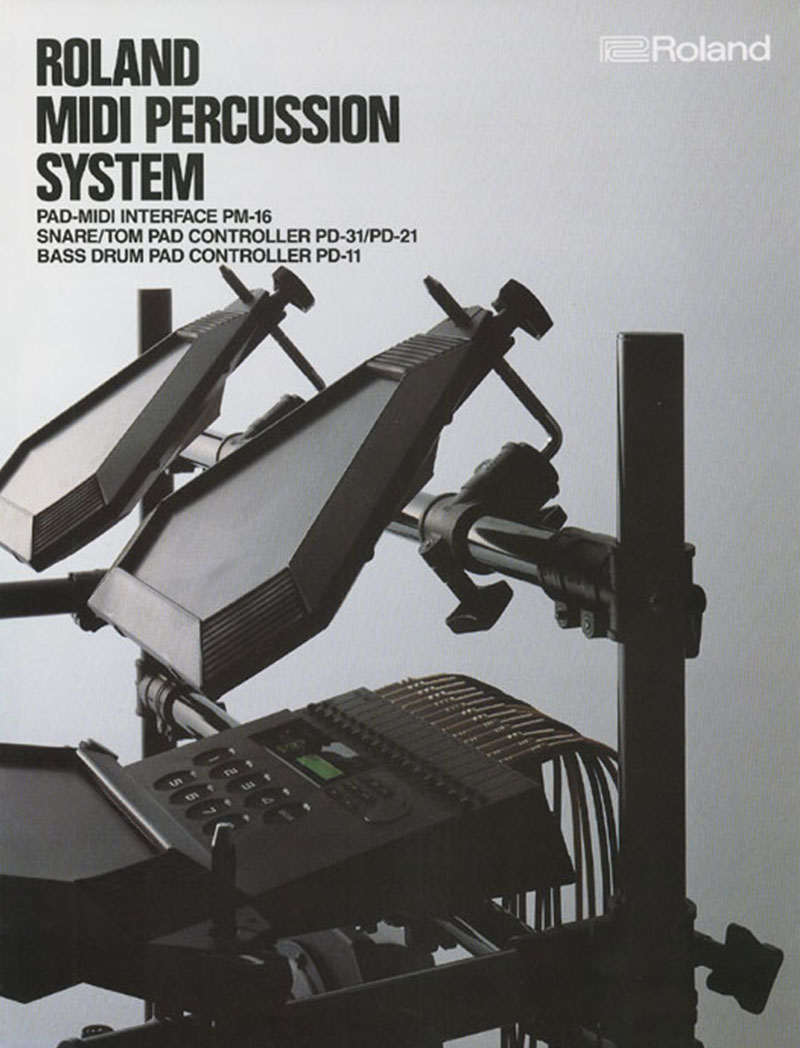
"The PD-11, PD-21, and PD-31 employed a bellows structure around the striking surface. This innovation helped reproduce the sinking of the stick during play."
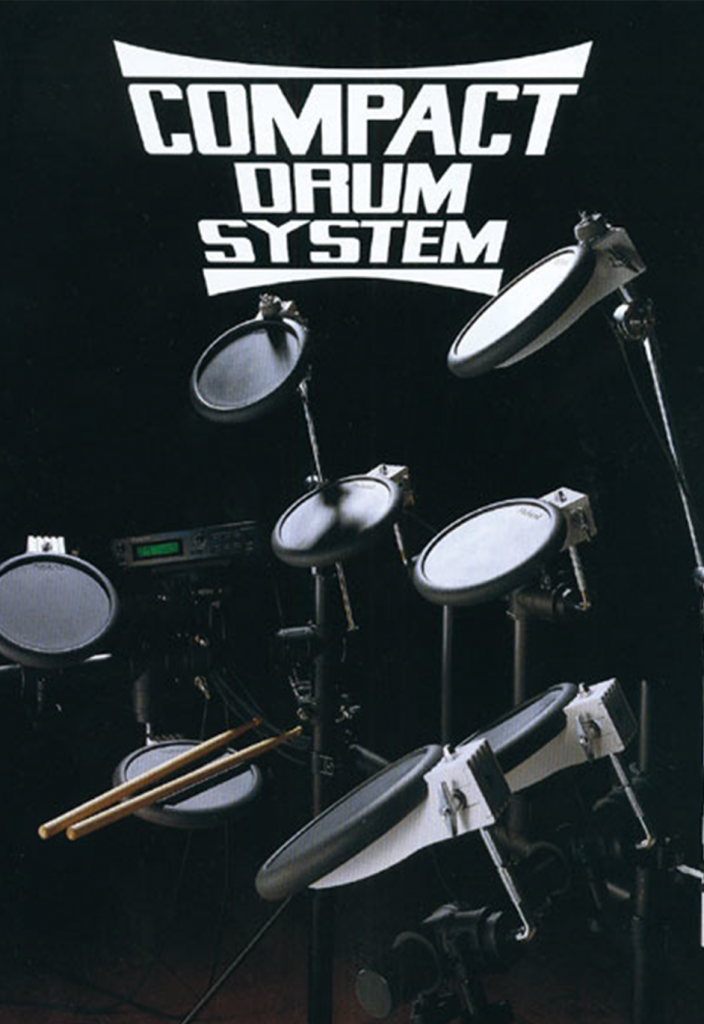
Homeward Sound
For its next drum system, Roland had planned for another large set. But a trip to the United States changed all that. “I realized the market needed compact electronic drums,” Katsuda remembers. “So we changed the plan and decided to develop an electronic drum that professionals could use as well as people practicing at home.”
The key to this was the small drum head size. Realizing the snare strike zone was around seven inches, the drum team, including former designer Kiyoshi Yoshino, decided on a pad with a compact 7.5 inches. In 1992, the TD-7, a compact drum system, was born. “To be honest, I didn’t know if a compact drum would sell until I put it on the market,” Katsuda admits. “It sold very well.” Both pros and amateurs bought it for home practice. The addition of cymbals helped make it a hit.
At the center of the kit was the TD-7 Percussion Sound Module. With 512 16-bit sounds, 256 waveforms, 32 editable patches, onboard effects, and even a sequencer, it was a significant improvement over earlier drum modules.
Inspiration from a Trampoline
Not content to sit still for long, the drum team continued to work in the background. The technology the team developed would soon have a massive impact on the drumming world. At Winter NAMM in 1997, Roland debuted V-Drums.
"We changed the plan and decided to develop an electronic drum that professionals could use as well as people practicing at home."
Masato Katsuda
V-Drums were a breakthrough physically and sonically. “We had been on a quest for a comfortable, acoustic drum-like playing surface that was quiet enough to practice with at home,” Yoshino recalls. A chance visit to a store changed everything. While at a housewares shop, Yoshino spotted a child’s trampoline for sale. A lightbulb went off in his head: it was quiet, had good tension, and was durable. Perhaps this was what he’d been seeking.
His team set about working up a prototype. They removed the film from the head of an acoustic drum and replaced it with a thin layer of polyester used in industrial filters. He tried hitting it. “It was quiet, and my hands didn’t hurt,” Yoshino recalls. “I did it!” Still, they weren’t out of the woods yet. He used two layers of a small mesh yarn, with the layers set apart by 45 degrees, to add tension and replicate the feel of a skin stretched over a drum. It worked. They’d invented the mesh pad.
Mesh Collaboration
But who would manufacture it? Roland made electronics, not drum heads. In 1996, Roland met with Remo to discuss collaborating. After explaining how quiet the heads would be, they struck a deal. As a result, Remo actively cooperated in manufacturing.

“We had been on a quest for a comfortable, acoustic drum-like playing surface that was quiet enough to practice with at home.”
Kiyoshi Yoshino

V-Drums Evolve
Further V-Drum advancements included the V-Kick in 1998, V-Cymbal in 2001, and V-Hi-Hat in 2004. The list of artists who play V-Drums is massive. Notable users include Neil Peart, Travis Barker, Stephen Morris (New Order), Roger Taylor, Larry Mullen, Jr., and many others.
Sonically, V-Drums use COSM, or Composite Object Sound Modeling, first developed for the V-Guitar. This modeling technology went beyond conventional technology to include the totality of the object it represented. The TD-10, the flagship module for V-Drums, featured 600 sounds, 50 kits, and 50 melody instruments. In addition, it sensed where players hit the pad, adjusting the sound much like an acoustic drum.
Roland has continued to modify and improve its V-Drums and components. Highlights include the top-of-the-line chrome emblazoned TD-20KX kit and Roland’s recent VAD series. The latter evoked the acoustic drum experience with the audio control modern players and producers require.
Unique Designs and Innovations
Roland sound synthesis has continued to evolve. Later advances included SuperNATURAL (2012), Prismatic Sound Modeling (2016), and 2020’s PureAcoustic Ambience Technology. The latter added a sense of realism to the drums in terms of physical space.
While Roland was developing and refining electronic drum kits, the company also pioneered instruments that didn’t necessarily conform to existing shapes. While not reminiscent of traditional drums, many forward-thinking drummers adopted them. Nowadays, these instruments are indispensable parts of the modern drummer’s toolkit.
"The TD-10, the flagship module for V-Drums, featured 600 sounds, 50 kits, and 50 melody instruments. In addition, it sensed where players hit the pad, adjusting the sound much like an acoustic drum."
Eight Is Enough: The Octapad
The same year Roland debuted its Alpha Drum System, it released the PAD-8. Also known as the Octapad, this MIDI controller had eight pads for triggering sounds from external devices, such as a drum machine, sampler, or synthesizer. Users could play the PAD-8 chromatically, making it a percussionist’s instrument as much as a drummer’s. The PAD-8 was incredibly popular and used by artists like Phil Collins. It also started a line of Roland trigger-based drum pad products that continues today with the SPD-SX PRO.
In 1988, Roland upgraded the PAD-8 to the PAD-80 Octapad II with 64 patch locations, three-note layering per pad, and patch chaining. Two years later, in 1990, the SPD-8 took the idea of the original Octapad and added internal sounds, turning it into a mobile drum kit. Music communities in Latin America and India adopted the SPD-11 and SPD-20. In India, Octapad players are in high demand; one can even look these specialists up in the phone book under Octapad performer.
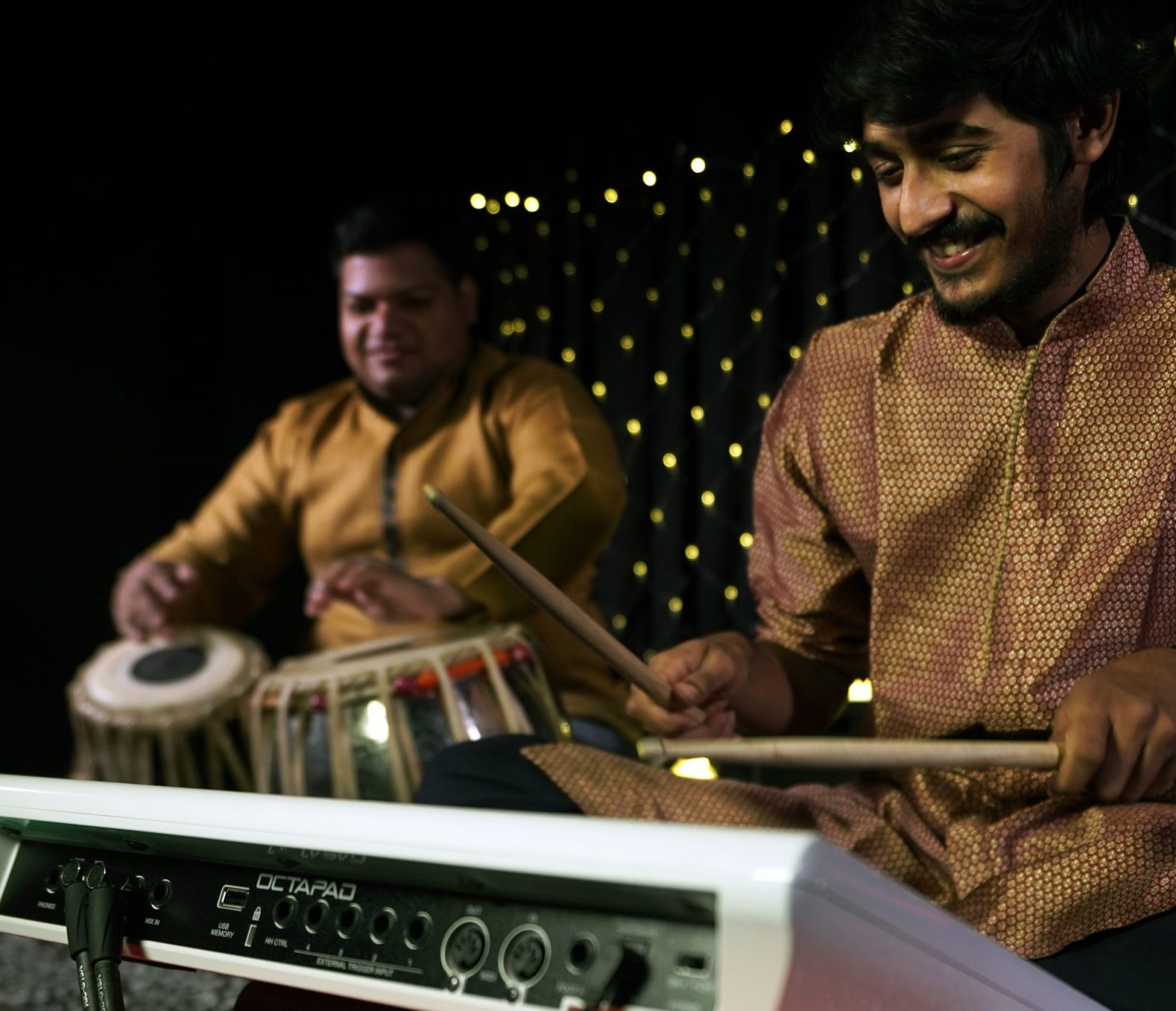

HandSonic
Not every drummer or percussionist plays with a stick. Many, like conga and bongo players, use their hands. It was for them that Roland made the HPD-15 HandSonic in 2000. Incorporating V-Drum technology, it had 600 sounds and 15 pressure-sensitive pads, ribbon controllers, a footswitch, and dual trigger input. Additionally, it contained a D-Beam controller to expand the idea of drumming. A four-track sequencer and onboard effects completed the package.
"The Octapad was a MIDI controller with eight pads for triggering sounds from external devices, such as a drum machine, sampler, or synthesizer."
SPD Revolution
It’s essential to be able to customize one’s instrument, especially in a live environment. Players often want the same drum sounds live as on a record. In 2003, Roland’s SPD-S, a sampling pad, changed the game by allowing CD-quality sampling at 16 bits and 44.1kHz. Its 16MB of RAM meant it could handle up to 12 minutes of stereo sampling. The CompactFlash card slot allowed for easy import/export. Plus, the built-in effects processor ensured you could get the exact sound needed right from the unit. Finally, thanks to the three edge pads at the top of the nine-pad array, players weren’t restricted to hitting pads straight on.
“Aiming for more compactness, the SPD-S initially consisted of six pads: three main pads and three shoulders,” remembers team member Katsuda. “To promote the potential of electronic instruments, we added three pads.”
The SPD line continued to evolve, with the SPD-30 Octapad version in 2010 and the SPD-SX upgrade in 2011. 2022 saw the release of the SPD-SX PRO, a sampling pad for the modern age. This model features a 16-bit, 48kHz sampling rate, 32GB of internal storage, 200 kits, more than 1500 pre-loaded waves, plenty of effects, and more. There are customizable multicolored LEDs separating the pads, letting players see the color-coded pad outlines.
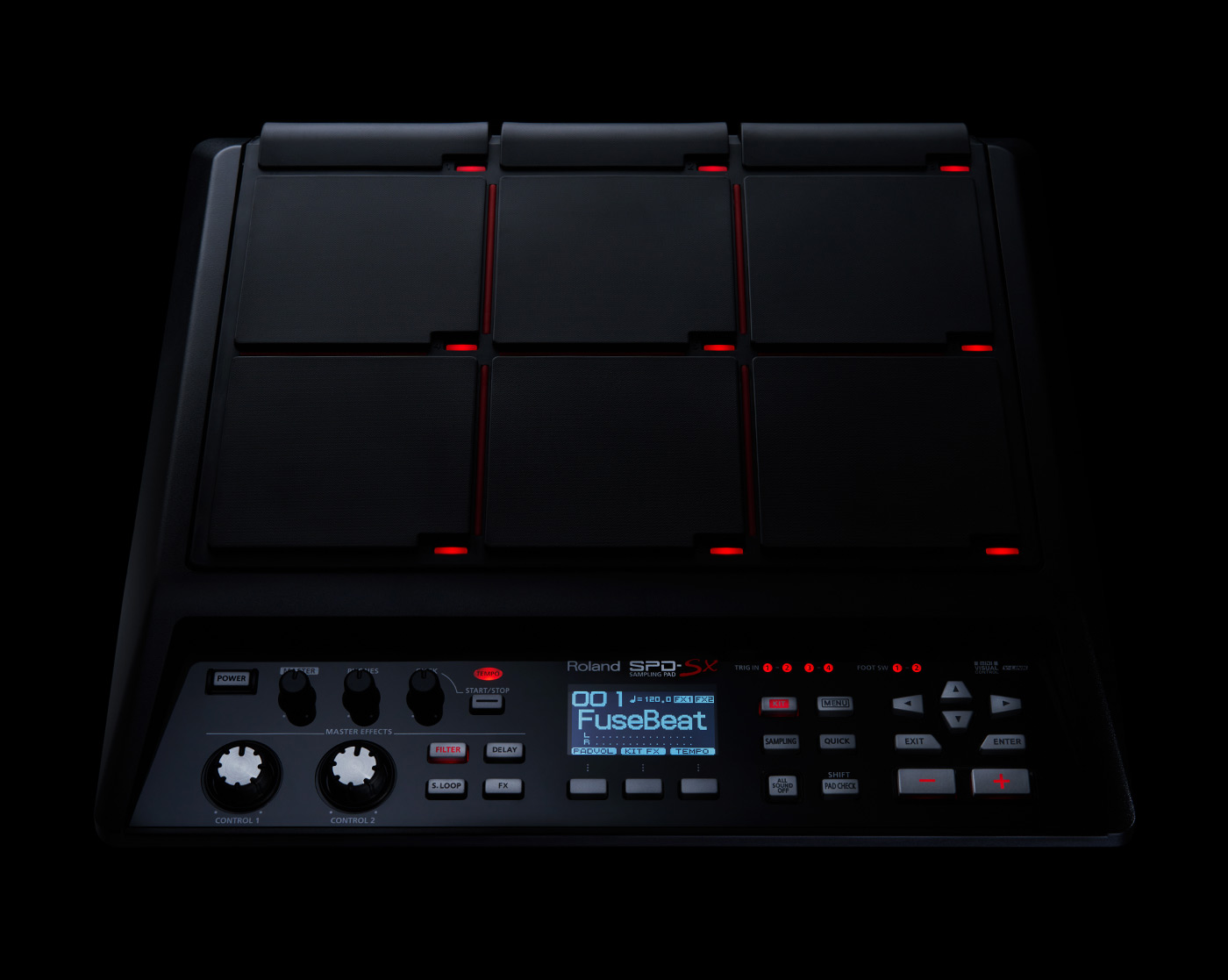

"Aiming for more compactness, the SPD-S initially consisted of six pads. To promote the potential of electronic instruments, we added three pads."
Masato Katsuda
The 50th Anniversary Concept Model
The Roland company’s classic slogan is “We design the future.” Indeed, 2015’s hybrid El Cajon and the VAD lineup blur the line between tradition and innovation. Much like these, the conceptual 50th anniversary model expands notions of drums and drumming.
The kit cuts a dramatic figure. There are two color schemes: A simple and modern white and chrome version and a black version with attention-grabbing red highlights. The shape of the pads is also unusual. Triangular with cut vertices, they recall the clean, geometric lines of the original triangular Alpha Drums but with blunted edges. It’s futuristic but linked to the recent past—a 21st-century upgrade of a classic design. The 50th anniversary concept model can create many sounds from a single pad. These include pitched chromatic tones, chords, and long bass notes, with filters that modulate with the beat.
Project D-FLUX
As the attention-grabbing polyhedral shape and Latin name suggest, Alpha Drums were the inspiration behind D-FLUX. This time, Roland upgraded the design with mesh pads, a technology that didn’t exist in 1985. The kit takes a cue from the second-generation PD-31 and includes multiple sounds on a single pad. Each pad can hold three tones, arranged individually around the edge and mixed in the middle to allow stacking or triad chords. Additionally, users can arrange three additional sounds around the rim. Technology developed for the V-Drums and Taiko-1 contribute to the new pads.
Yusuke Tanakadate, who developed the pad for this concept model, explains: “We call this 50th anniversary concept model project D-FLUX. The d comes from Delta and represents the shape of the pad and its association with the original α drum. It is also the D in the word drum. For the concept model, we combined it with the word flux, which means flow, because we wanted to create a new change.”
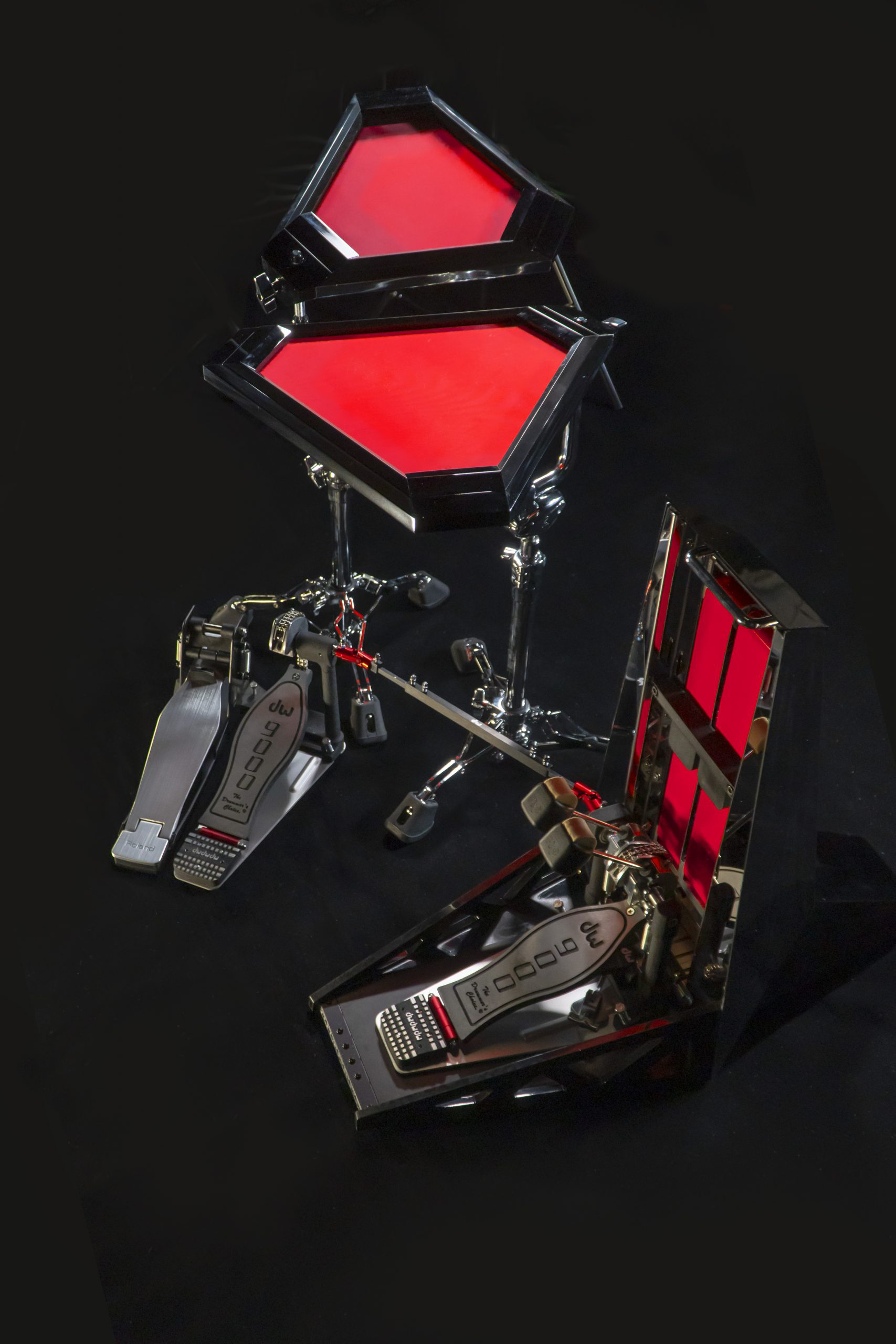
"The D-FLUX concept model can create many sounds from a single pad. These include pitched chromatic tones, chords, and long bass notes, with filters that modulate with the beat. "
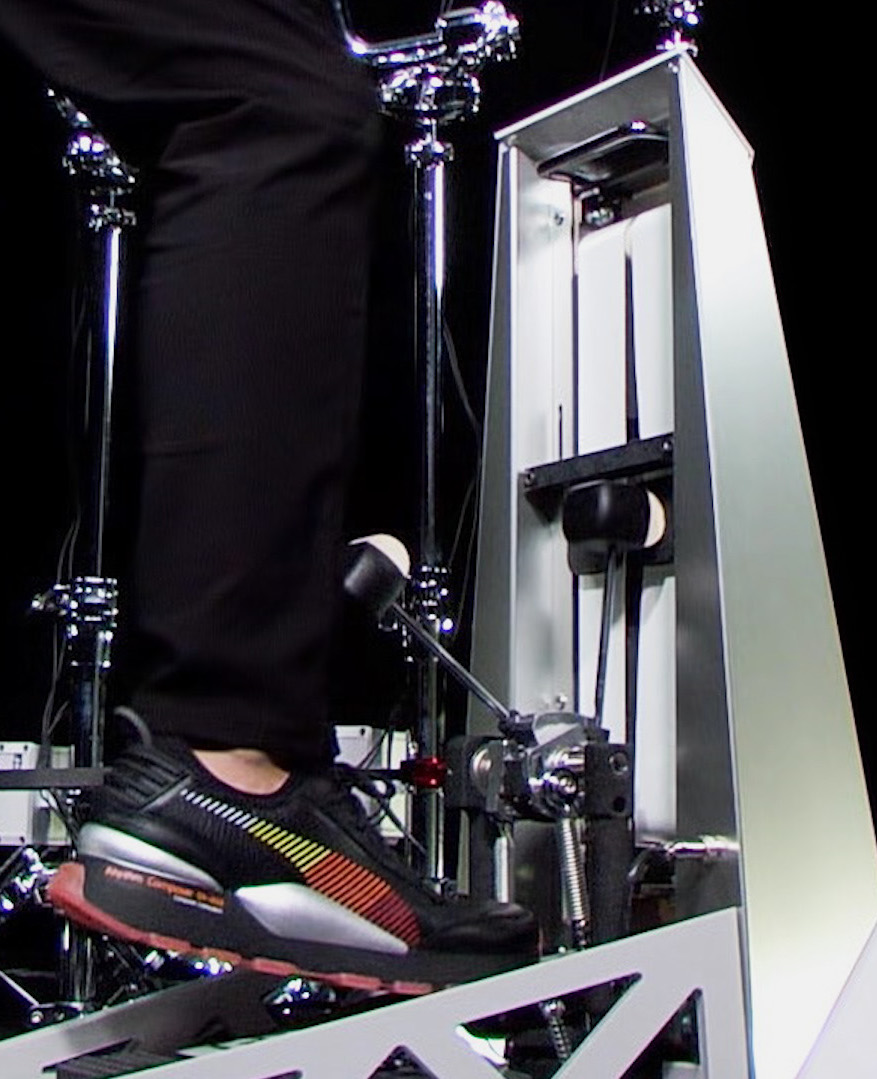
“As a premise, we developed this concept model to be an electronic multi-purpose percussion instrument. It’s not only for use with drums but with multi-purpose instruments,” explains Yusuke Tanakadate, creator of the D-FLUX concept model’s pads. “Drummers and percussionists can use it alone or combine it with other instruments like hybrid drums and percussion,” he adds. “It’s also intended for DJs and producers to use in various ways, such as during performances.”
Although it started with the goal of creating an unusually shaped drum that was comfortable to play, the idea expanded. “By digging deep into applications and playing methods, we created this concept model, a unique evolutionary direction for electronic instruments,” Tanakadate says.
D-FLUX Belt Kick
The kit’s unique kick utilizes two beaters and two belts instead of traditional mesh pads and a rubber striking surface. Kiyoshi Yoshino illustrates how the Belt Kick works. “The beater on the kick pedal hits a small surface, but the tension of the large head is ideal for the gentle bounce of the acoustic kick. However, you need a large body and can only produce the same sound even though you are playing with two beaters with twin pedals. The two beaters can be played independently, and two belts are excellent for reproducing the tension of the large head.”
"We believe the D-FLUX concept model has a presence that is as strong as acoustic drums or other instruments."
Yusuke Tanakadate
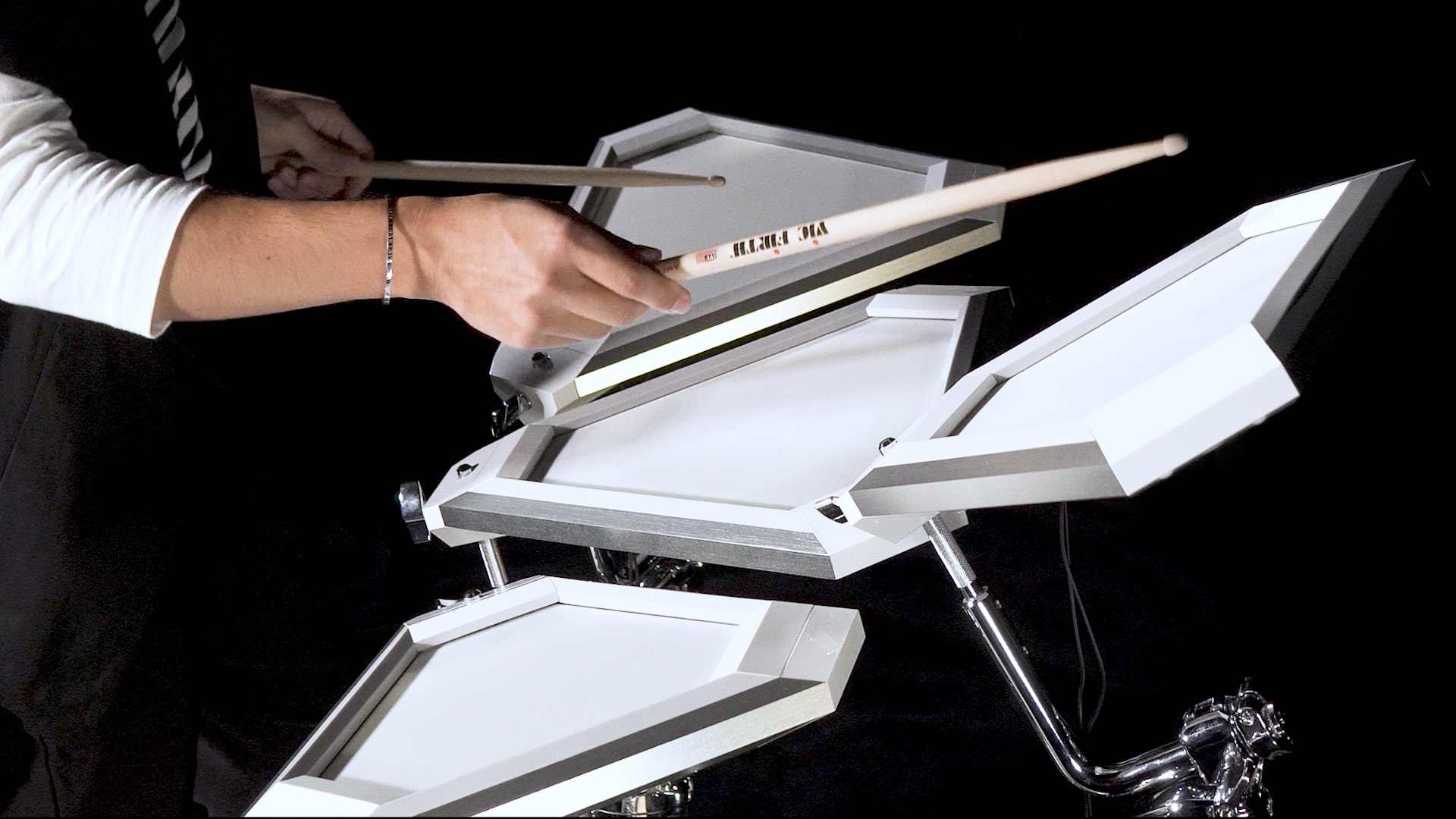
A Strong Presence
Yoshino also continued on the merits of this quirky belt striking surface. “Since the beater is directly deformed in response to the beater being held down, we have made it possible to perform an ‘open/close playing method’ in which the beater is immediately released or held down by detecting it with a sensor,” he says, “and an epoch-making after-touch performance in which the sound is extended while the beater is held down and the tone is changed by stepping further.”
Aside from its technical merits, the Belt Kick packs a visual punch. Although compact, it functions as the center of the kit. “The design has a strong presence while emphasizing the basic skeleton of the Belt Kick,” Tanakadate stresses. “We believe the D-FLUX concept model has a presence that is as strong as acoustic drums or other instruments.”
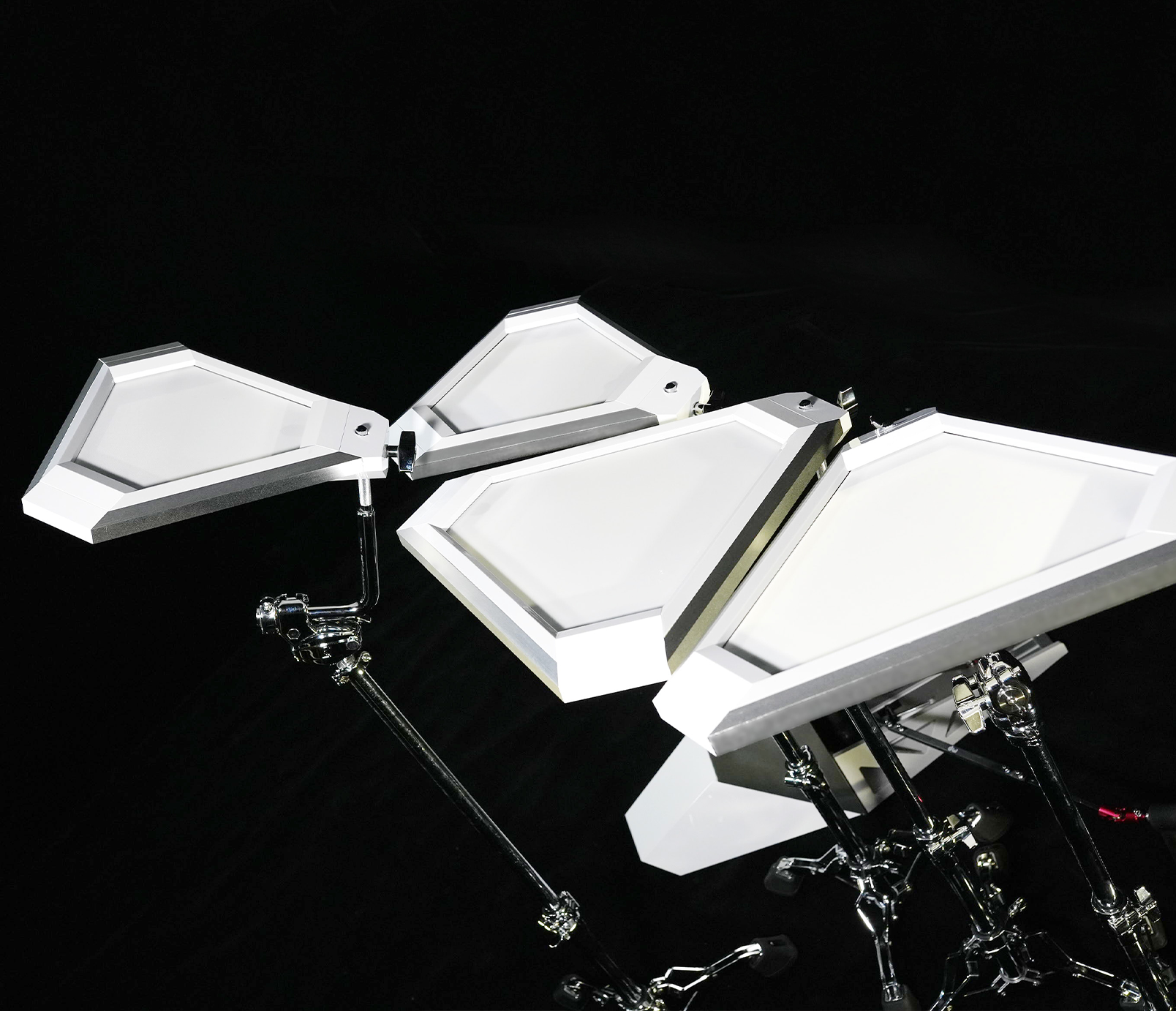

Into the Future
With D-FLUX, Roland is pointing toward the next stage of its drum development. These are drums—but from an entirely new paradigm. D-FLUX will soon embark on a global tour where drummers will have a chance to experience it.
In September 2022, legendary acoustic drum manufacturer DW (Drum Workshop) joined the Roland group. One can only imagine the drums that may come from this union. As always, the future of Roland remains a joyous, musical mystery.
